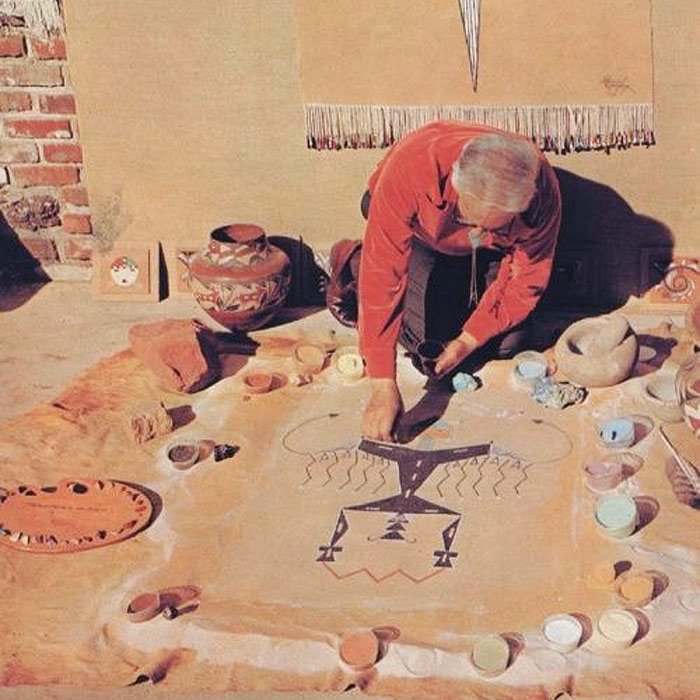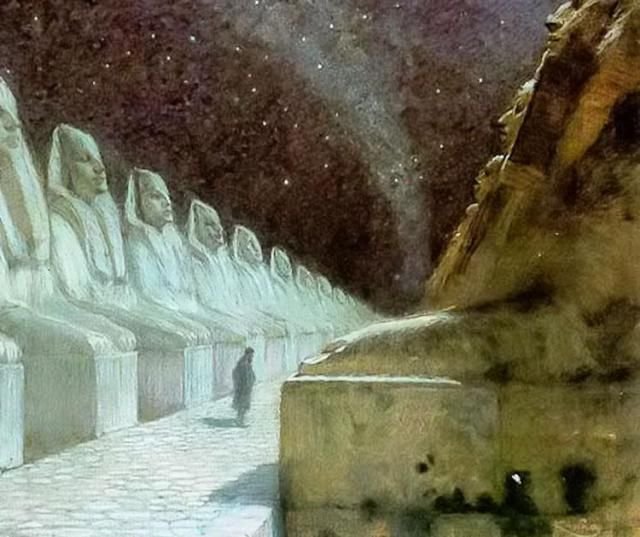22. In the Arena of Sand
Show Notes
Big 3 Ideas from this episode:
Brene Brown’s challenge to “Enter the Arena”
The Roman Arena = The Place of Sand
Inner to Outer: Sand Play, The Beach, The Desert
Henri Rousseau, Sleeping Gypsy, 1897
Frantisek Kupka, Sphinx, 1900, aquatint print
Monk at the end of the sand mandala cycle - destruction & impermanence
“One of the main Buddhist concepts is impermanence, The mandala is constructed to be dismantled immediately. That shows impermanence. It also should cultivate non-attachment in the person, including the artist making it. Making the mandala itself is meditation, it requires great concentration, and the symbolism contained in it is understood in the Tibetan tradition to empower the meditator.”
- Dr. Eve Mullen, Oxford College
Willem de Kooning, Legend and Fact, 60 x 190 7/16 inches (4 panels), National Gallery of Art
-
Episode 22: In the Arena of Sand
===
If you are a fan of surrealism, you may have noticed a theme. Many surrealist paintings are set either on a beach or in a vast desert. often with ruined Roman pillars and arches like an abandoned theater where a surrealist drama is playing out against the mystery of an empty backdrop. and I've been feeling a strong connection between that surrealist place of sand and the concept of the arena That Brene Brown talks about when she says, if you are not in the arena, also getting your ass kicked. I am not interested in your feedback.
[00:01:05] This is a bold call to action and a rebuff to trolls and onlookers in the online space, and she was referencing Theodore Roosevelt. Who said " It is not the critic who counts, , not the man who points out how the strong man stumbles the credit belongs to the man who is actually in the arena, whose face is marred by dust and sweat and blood. Who strives valiantly, who errs, who comes short again and again.
[00:01:32] And who knows at the worst if he fails. At least he fails while daring greatly. Sometimes it feels like that moment in Spartacus. You're a gladiator and you're ready to step out into the arena. All eyes are on you. The one gladiator, waiting for that beast to be released that might devour you.
[00:01:52] The arena of online opinion of business and life is a frightening place. Especially since Covid, we are even more used to our caves, all comfy and well stocked with ice cream and Netflix.
[00:02:07] The word arena is Latin for the place of combat, but originally the place of sand, the sand was scattered on the ground to soak up the blood.
[00:02:17] And the whole reason the arena existed was for people to see the battle, to see the blood, and there was blood. There will be blood. Nowadays, more often, art and performance gives us symbolic metaphorical battles. And in our everyday lives as artists, the arena can shift places.
[00:02:36] Some days, the arena, the place of battle is in our minds where our thoughts can taunt and bully us into silence, paralysis and inaction or the arena can be in the studio where a new work of art can feel like a struggle with the muse who only wants to help by the way. Or with skills, technique, materials, even gravity and light can be our [00:03:00] foes, and we haven't even gotten to the door yet.
[00:03:03] , the place of battle out there in the public eye, . It's an arena of choice. The public forum of thought and opinion, and there's still an element of battle to it. I think that mentally every day, whether we put ourselves out there in a broader public forum or not, that there's a feeling when humans rise in the morning.
[00:03:24] Of being engaged, presenting oneself, whether you have a job, a business, a craft, an art, or a vocation overall. These are arenas of choice, and Brown is saying that unless you are willing to join in the conversation openly, that heckling the sidelines isn't accepted or helpful.
[00:03:47] Ironically, that is exactly what the original arenas, the Coliseum of Rome, or the amphitheater in Pompei were all about.
[00:03:57] Heckling in the Roman Coliseum. Up to 50,000 people would watch and yell and heckle as enslaved gladiators, convicted criminals and captured animals from birds to dogs, to horses, to bulls, to lions, to elephants, were abused in front of the crowd for their entertainment. I don't wanna linger on that, and you can research it for yourself, but I do think that the idea of the arena, the place of sand, the stage where sand is thrown to soak up the blood of the sacrificed, the enslaved, and those forced to fight is interesting because none of those fighters, animals, or human, had a choice.
[00:04:43] Now what Brene Brown is talking about is a totally different arena entering the conversation by choice and with focus, If we feel already worn down by the lions in our own mind, or the beasts in our own studios, it can be daunting.
[00:05:01] But just to be aware, we are entering the arena by choice Courage isn't always a pleasant emotion. it can be painful and scary.
[00:05:11] But when we know that we are going to experience these emotions of courage, emotions that will help us in the arena everything changes.
[00:05:20] so I want to shift the way I'm looking at the arena in her talk.
[00:05:25] Brown says that three. Main points came up for her. One, that it's not about winning or losing, but showing up and being seen.
[00:05:36] Two, she says, this is who I want to be. I want to create, I want to make things that didn't exist before I touched them. And the only certainty, especially if you are a creator, is that you will get your ass kicked.
[00:05:52] You have to decide if courage is a value you hold because this is a consequence.
[00:05:58] I want to give you three [00:06:00] more physical ways we can think about the arena, the place of sand that work from the inner to the outer, from the mind to the community, and the fascinating symbolism within them.
[00:06:15] The first is Sand Play. In the 1930s, psychologist Margaret Lowenfeld, created a fascinating method of therapy The World Technique. She worked with children and she realized how hard it was for them to talk about things that had happened to them and express their emotions.
[00:06:33] So she created trays of sand and let them play with figurines to act out and stage things that they might be thinking.
[00:06:42] In the clinic, two trays were often used, one damp and one full of dry sand, and little miniature figurines could be placed in the sand and the kids played with them to create little dramas or scenes. This helped them bypass the thinking cognitive mind.
[00:06:57] And she called it a form of picture thinking. Another psychiatrist, Dora Kalff took this practice and connected it further to Jung's framework.
[00:07:06] Kalff said in sand play, it immediately becomes clear that the human being can come closer to wholeness. Immersed in play, the person succeeds in making an interior picture visible.
[00:07:17] Although this is all about psychology, of course art makes sense here. Her favorite example to use was Mark Chagall, who painted flying animals and floating people like dream sequences.
[00:07:31] She said pre-verbal thinking has its own set of rules. There's no time or space, but many concepts are presented together and are multidimensional.
[00:07:40] Kids get to play out what's going on rather than having to talk about it.
[00:07:45] Dreams and art just have a different logic than life.
[00:07:49] So as artists our arena. That place of sand and battle Can be a safe space where we play out our dreams, play out our art, and work through our own archetypes and our own issues and our own concepts.
[00:08:05] It was really fascinating researching this episode. Because I came across a reference to Lowenfeld's Clinic. It was called the Children's Clinic for the Treatment Study of Nervous and Difficult Children.
[00:08:18] I'm not sure my parents would've told you that I was a nervous and difficult child. I think I put on a good face as sort of a golden child, but inside there was a lot of turmoil.
[00:08:29] I think a lot of artists can relate to this as
[00:08:32] highly sensitive people. If you've not seen the documentary called Sensitive, it's really good. It's really worth seeing.
[00:08:40] This clinic was in Notting Hill, London. I used to live in Notting Hill for a short period of time. I even mentioned the park bench outside the Notting Hill Library, where I really first decided that I was a writer. From that park bench it turns out it's a five minute walk to six [00:09:00] Pembridge villas. The original place where Lowenfeld created the World Technique or sand play.
[00:09:06] As a kid, I think I created a safe, imaginary space for myself. To play out some of my own inner difficulties, and I know that most children do, but it's fascinating that just as. Lowenfeld's Clinic was just down the road. I was on that park bench just five minutes down the road, working out my own difficulties.
[00:09:30] The sandbox can be a stage to explore images, but also a sacred space for healing.
[00:09:36] Jung says The hand knows how to solve a riddle that the intellect has wrestled with in vain, and there's that battle metaphor again, you can just picture the intellect out there in the arena battling in vain with a riddle it's trying to solve. Sand therapy was called a free and protected space, a place of constraint, containment, grounding, and creativity. We all need that.
[00:10:04] The idea of sand play is also at the base of shamanistic and mystical traditions around the world, including Buddhism, where monks build sand mandalas and then destroy them in order to explore the ideas of impermanence and non-attachment in Navajo and other Native American traditions.
[00:10:22] A wise elder would create a sand painting from seven different colors of sand,
[00:10:26] and the person that came to be healed would sit in the center of the painting. The legend is that the gods made the first paintings. and they ask the humans to continue to make them, but that the paintings must be made of sand and they must be destroyed before sunset. As the painting is revealed, the different sands, feathers and plants are added to it.
[00:10:49] There's also a chant that is revealed and then that is performed for the ritual to be complete.
[00:10:56] The sand here absorbs the evil that has created the sickness, and then that sand is taken out and transferred to four places in the four directions so the earth can heal it. In Aboriginal Australia, the sand stories are used to pass on history and memories, to teach tribal wisdom and to show where natural features, food sources, dangers, and animals are in the landscape. And the creation myth starts here in a vast, empty land. Where the God-like human figure sings his sons to life.
[00:11:31] So music and this place of emptiness is always connected.
[00:11:35] In Zen Gardens, the pebbles. Are used to show how energy and the elements move to encourage meditation. The contrast of dark and light, different forms of stones, sand, trees, moss. It's a place of attention and detachment.
[00:11:52] I told you that I would share with you three physical places where the arena, [00:12:00] the place of sand, can be transformed from a battleground to a place of hope, healing, and creativity. The first one, sand play just ended up being such a big subject. being played out in so many cultures with sand paintings and psychotherapy and ritual, that I think that's enough for today.
[00:12:24] Next time I'll move out into the beach and the desert, the liminal space between sand and sea and the open desert of endless time.
[00:12:35] Thank you so much for listening, and I hope you have a courageously creative week.
[00:12:40] if you're an artist who wants to sell and market your work more effectively, join us in the Metaphor Mindset Studio, an online program for artists who want to love their business as much as they love their art.
[00:13:00] Metaphor, mindset, studio. Think like an artist, work like a boss.
References:
Brene Brown, The Man in the Arena: https://www.youtube.com/watch?v=-s6DQrqVHxM
Brene Brown, Daring Greatly: https://brenebrown.com/book/daring-greatly/
Navajo Sand Painting documentary, 1941: https://www.youtube.com/watch?v=fcYYj7Ye6_A
Artist Rianna Lotter’s Aboriginal Symbols: https://www.youtube.com/watch?v=Hyz-RsEfZv0
Capturing a connection to country (article about Lowell Hunter by Kylie Oliver): https://timesnewsgroup.com.au/surfcoasttimes/living/capturing-a-connection-to/
Monks take days to build a mandala at Oxford, then destroy it in hours: https://www.ajc.com/lifestyles/religion/monks-take-days-build-mandala-oxford-then-destroy-hours/T3fMpI2GucnJsYlnpFbtjO/




















